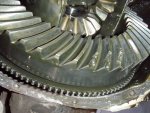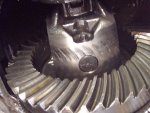yo,
Good on the self test pass codes so iggie that unless you get a Check Engine Light (CEL) or have other issues.
open the diff. & check for tone ring (Ford calls it the exciter ring at times) damage; if none, clean as much as possible.
next is:
PSOM Pointer Waiver TSB 96-21-11 by Ford for 92-96
Programmable Speedometer/Odometer Module Pointer Waiver Article No. 96-21-11
ISSUE: The speedometer needle may waver and/or a light surge may occur on some vehicles when speed control is used
at highway speeds between 80-113 km/h (50-70 mph). This may be due to slight dents/chips in either the exciter ring
or the Vehicle Speed Sensor (VSS) and air gaps between the VSS and the exciter ring.
ACTION: Replace the Programmable Speedometer/Odometer Module (PSOM) if required. New PSOM's come with increased immunity to system variability. Refer to the following Diagnostic Procedure for details.
DIAGNOSTIC PROCEDURE
BRONCO/F-SERIES - Perform normal PSOM diagnostics per Pinpoint Tests "H" and "J" of the 1996 F-Series/Bronco
Body/Chassis Service Manual, Pages 13-01-30 through 13-01-32 and Pinpoint "B" of the 1996 Powertrain/Drivetrain Service Manual,
Page 10-03-11.
1.
Any slight dents, chips, etc., in either the exciter ring or VSS will create needle waver. Measure air gap between the VSS and exciter ring. It should be 0.38-0.51 mm (0.015-0.020").
2. Check exciter ring runout per the same ring gear backface runout procedure of the appropriate model 1996
Powertrain/Drivetrain Service Manual, Section 05-00. Make sure the exciter ring is mounted correctly to the
ring gear. If runout is more than 0.1 mm (0.004"), perform the differential runout check per the procedure in the
appropriate model 1996 Powertrain/Drivetrain Service Manual, Section 05-02A or 05-02D, to find cause and repair as needed.
3. If all items listed above check good, replace the Instrument Cluster Assembly. Obtain the correct service part number from the Parts Catalogue
and then contact the Electronic Odometer Exchange Center at (800) 259-9700 for U.S. Dealers and (800) 663-9974 for Canadian Dealers.
NOTE: DEALERSHIP MUST TELL THE ODOMETER EXCHANGE CENTER THAT YOU NEED A PSOM3 LEVEL CLUSTER FOR A SPEEDOMETER NEEDLE WAVER CONCERN.
OTHER APPLICABLE ARTICLES: NONE
WARRANTY STATUS: Eligible Under The Provisions Of Bumper To Bumper Warranty Coverage
Bronco 962111B Replace Programmable 0.7 Hr.
BASIC PART NO. CODE 10849 06
read more in my site @
http://home.comcast.net/~miesk5/technical_service_bulletins.htm#technical_service_bulletins.htm
I wouldn't replace cluster yet if tone ring looks ok. Can do the other tests to rule out bad wiring at connectors, etc.
If tone ring is damaged;
Tone Ring (also called Exciter Ring) Source & pic; Item #32392; "...This is the ring inside the axle housing that the speed/abs sensor reads off of. 8.5" outside diameter, 108 Teeth..."
$38.00
and Bronco Zone members ger a discount!
Jeff at the Bronco Graveyard has offered a 2% discount to members of The BroncoZone for on line orders. To get your discount, enter the discount code BZMEMBER. Also you must include your BroncoZone User Name with the order
Source: by Jeff's Bronco Graveyard
Tone Ring Removal/Installation (also called Speed Sensor Ring) w/additional info incorporated by Steve83
Source: by Dave's Bronc 90
1- Remove carrier cross pin bolt, and then the pin.
2- Push in each axle to expose the c-clip, then remove the c-clip and pull the axle out of the carrier.
3- Mark the orientation of the bearing caps... The bearing caps are marked for direction when they're cast. Remove bearing caps.
4- Pull out the carrier, taking extreme caution to not mix up the bearing races and shim packs. They must go back in exactly as they are in right now, or you'll have to do a full gear set up when you put it back in.
5- Don't remove anything from the carrier that doesn't fall off.
6- Find the internal locating tooth on the tone ring, then spin the carrier 180° & pry the damaged tone ring away from the ring gear. When it comes off the carrier, push it to disengage the locating tooth.
7- Hook the tooth of the new tone ring into the pocket on the lip of the carrier behind the ring gear, and tap it on.
8- Put the carrier back in taking care to put the bearing races and shim packs back in their original positions.
9- Reinstall the bearing caps in their original positions, use a lot of red LocTite and torque to spec.
10- Slide the axles back in and reinstall the c-clips.
11- Reinstall the cross pin & a NEW bolt, torquing to spec.
That's pretty much it. It's not hard to do at all, you can do it in less than a half hour.
additional comment by jopes; "...If you heat the tone ring with torches or a oven, there is no need to tap it on. you can set it on with ease. Those tone rings are so thin you can break them if you look at them funny..."






